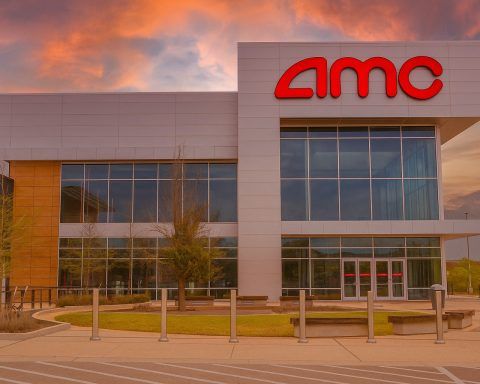Introduction: Cooling Sentiment After a Red-Hot AI Run
Super Micro Computer (SMCI) – better known as Supermicro – has hit a rough patch after a stellar run driven by the AI server boom. The stock’s meteoric rise earlier in 2025 has given way to a sharp pullback in recent weeks. In fact, SMCI shares have tumbled over 33% in the past month alone as investors reacted to a disappointing earnings miss and cautious guidance [1]. This sentiment shift comes despite Supermicro’s prominent role in powering artificial intelligence (AI) data centers, making the company’s recent performance and future outlook highly relevant to investors in AI server stocks. Below, we analyze the latest Super Micro Computer news, financial results, industry trends, and forecasts for SMCI stock as of mid-November 2025.
Latest Super Micro Computer News: Earnings Miss Amid AI Server Delays
Supermicro’s fiscal Q1 2026 earnings (reported November 4, 2025) fell short of expectations, rattling the market. The company posted net sales around $5.0 billion, a steep ~15% drop year-over-year and well below its earlier guidance of $6–$7 billion [2]. Adjusted earnings were equally soft at $0.35 per share, missing Wall Street’s $0.46 consensus and less than half of the $0.73 EPS a year prior [3] [4]. Management attributed the revenue shortfall to timing issues – specifically, last-minute design upgrades for major AI hardware orders that pushed some shipments into next quarter [5]. CEO Charles Liang noted that some customers delayed platform decisions, causing AI server deliveries to slip into upcoming quarters [6].
This hiccup comes after a period of extraordinary growth. Supermicro rode 2024’s AI wave to astounding revenue gains – at one point notching +180% year-on-year growth – but each successive quarter saw growth decelerate into 2025 [7]. By the June 2025 quarter, revenue growth had slowed to single digits, and now the latest quarter turned negative. The AI server demand itself remains robust, but Supermicro’s ability to execute and fulfill orders on time has been challenged by the complexity of new GPU systems and supply-chain adjustments. Gross margins have also been under pressure, sliding to 9.6% in the recent quarter from over 15% a year ago [8]. This reflects tighter profitability as growth cooled and costs rose.
Despite the setback, Supermicro’s management struck an optimistic tone for the coming months. They emphasize that the company is still in the “early phases” of a massive AI infrastructure upgrade cycle [9]. Many delayed projects are expected to land in upcoming quarters, supporting a sharp rebound in sales. In fact, Supermicro raised its full-year revenue forecast for fiscal 2026 to at least $36 billion (up from $33B), reflecting confidence that deferred AI hardware orders will be recognized soon [10]. About three-quarters of Supermicro’s revenue now comes from AI GPU platforms, which remain the key growth engine [11]. The demand pipeline appears strong, but the recent earnings miss shows that timing and execution are critical for the company to fully capitalize on the AI boom.
AI Server Industry Trends and SMCI’s Strategic Initiatives
The broader AI server and data center market continues to expand rapidly in late 2025, although investors have become more selective. Hyperscale cloud providers and enterprises are investing heavily in AI-optimized hardware, benefiting suppliers like Supermicro. However, competition is fierce – larger rivals such as Dell Technologies and HPE are aggressively rolling out their own AI server offerings. Supermicro’s recent margin compression highlights this dynamic, as intense competition has eroded some pricing power versus industry giants [12]. The company’s gross margin has declined four quarters in a row, prompting concern that bigger competitors can undercut on pricing [13]. This competitive backdrop makes Supermicro’s differentiation and execution more important than ever.
On the positive side, Supermicro has been rapidly expanding its product portfolio to stay ahead in the AI hardware race. In late September, the company showcased a slew of new AI-optimized servers at its INNOVATE! EMEA 2025 event in Madrid, featuring the latest NVIDIA HGX B300 GPUs and full rack-scale AI solutions [14] [15]. These systems, including liquid-cooled GPU servers and edge AI devices, demonstrate Supermicro’s commitment to cutting-edge technology. The company noted that its entire expanded AI portfolio is now shipping globally from manufacturing sites in the U.S., Netherlands, Taiwan, and Malaysia [16] – a global footprint that helps meet surging demand. Additionally, Supermicro is delivering next-gen NVIDIA “Blackwell” GPU platforms; management revealed that the flagship GB300-based systems have already garnered over $13 billion in orders as production ramps up [17]. This suggests that Supermicro remains at the forefront of the AI server trend and stands to capture a significant share of the ongoing AI data center build-out.
Supermicro is also taking strategic steps to address geopolitical and government market opportunities. In late October, the company announced the formation of Super Micro Federal LLC, a dedicated U.S. federal business unit [18]. This new subsidiary will focus on supplying AI-optimized, domestically manufactured IT infrastructure to U.S. government agencies [19]. By leveraging Supermicro’s Silicon Valley production campus and its Data Center Building Block Solutions®, the company aims to meet federal demand for secure, on-shore computing solutions [20]. This move not only opens a potentially lucrative customer segment (government contracts) but also aligns with U.S. policy trends favoring local manufacturing – a savvy response to tariffs and supply chain nationalization. In parallel, Supermicro continues to expand manufacturing capacity, exploring new facilities in the U.S. and scaling up its large Malaysia factory to support the next leg of growth [21]. All these initiatives underscore that while short-term hiccups exist, the company is positioning itself to ride the long-term AI infrastructure wave with a broader product lineup and deeper market reach.
Analyst Sentiment and SMCI Stock Price Targets
Wall Street analysts have reacted mixedly to Supermicro’s recent developments. The consensus rating on SMCI has drifted to a cautious “Hold”, reflecting the balanced view of strong long-term prospects against near-term uncertainty [22]. The average analyst price target now sits in the high-$40s (around $48.38 as of mid-November) – roughly 30% above the recent trading price in the mid-$30s [23]. However, price targets have been trimmed by several firms after the earnings miss, and there’s a wide dispersion of opinions. For instance, on November 5th Goldman Sachs reiterated a “sell” rating with a $34 target, citing concern over profitability [24]. Barclays and Wedbush also cut their targets into the low-$40s and maintained neutral stances [25]. On the bullish end, Argus Research upgraded SMCI to a Buy on November 7th with a Street-high $64 price target, arguing that the recent pullback presents an attractive risk-reward for an AI leader [26]. Northland Securities likewise issued a target in the low-$60s [27].
This range – from about $34 on the low end to $64 at the high end – shows that analysts are divided on Supermicro’s trajectory. Key debate points include how quickly the company can resume its growth pace, whether margins will recover, and how much competition or macro headwinds (like high interest rates and tech export restrictions) might cap its upside. Importantly, management’s own outlook is bullish: they guided for $10–$11 billion in revenue next quarter (Q2 FY2026) which, if achieved, would more than double sequentially and mark a re-acceleration in growth [28]. If Supermicro delivers on that aggressive rebound, analysts may revise targets upward. For now, the consensus SMCI price target in the ~$48-50 range suggests cautious optimism – implying significant upside from current prices, but not without execution risks. Investors should note that Wall Street sentiment could shift quickly with upcoming results or guidance updates.
Technical Analysis: SMCI Stock Chart and Trends
From a technical standpoint, SMCI’s stock chart reflects its volatile journey through the AI hype cycle. The share price reached a 52-week high of about $60–$66 during mid-2025 amid peak AI enthusiasm [29]. Since then, the stock has been in a downtrend, falling to the mid-$30s by November. This slide has taken SMCI well below its 50-day (∼$48) and 200-day (∼$46) moving averages, confirming a loss of upward momentum [30]. In the last month alone, the stock plunged by roughly one-third as weak earnings and broader market profit-taking hit AI names. The relative strength index (RSI) and other momentum indicators (not cited here) likely moved into oversold territory during the steep October–November drop, though some stabilization has occurred around the mid-$30s.
Notably, SMCI remains above its year-ago levels – it is still up about 18% year-to-date [31] – but the recent retracement wiped out a large portion of 2025’s gains. The 12-month trading range now spans from a low around $17 (last November’s trough) to the ~$66 peak [32], illustrating how dramatically sentiment swung with the AI cycle. Current prices are roughly 40–45% below the highs, putting SMCI back near levels last seen in early 2025. On the chart, potential support may exist in the low-$30s (around the early-year breakout zone), while any rebound will face overhead resistance near $45-50 (where the moving averages and prior support converge). Trading volume spiked during the post-earnings selloff, indicating some capitulation and heavy turnover of shares. Such high volatility cuts both ways – it means sharp rallies are possible on good news, but also that investors demand conviction (and stomach) to ride out swings. Indeed, Supermicro has exhibited extreme volatility with dozens of 5%+ daily moves over the past year [33], so traders should be prepared for ongoing choppiness. Overall, the technical picture in late 2025 suggests a stock searching for a bottom; a definitive trend reversal may require a positive catalyst (such as evidence of revenues re-accelerating or margins improving in coming quarters).
Institutional Ownership, Insider Trading, and Short Interest
Ownership trends around SMCI reflect both conviction in the AI thesis and some profit-taking after the big run-up. Institutional investors hold approximately 84% of Supermicro’s stock [34], indicating broad participation by funds. Recent regulatory filings show a mixed picture: in Q3 2025, several hedge funds initiated or added to positions – for example, Credit Agricole S.A. bought a new $30 million stake during the third quarter [35] – while some others trimmed exposure modestly. One high-profile exit came earlier in 2025: Coatue Management, led by billionaire Philippe Laffont, sold its entire stake in SMCI by mid-year amid concerns about the company’s eroding margins and tough competition [36]. Laffont had been an early investor during the AI upswing but reportedly lost confidence as gross margins fell and Dell and other competitors loomed large】 [37]. His sale, disclosed in August, was seen as a sign that some smart money was locking in gains. However, it’s worth noting that many institutions still remain bullishly invested given Supermicro’s long-term prospects in AI infrastructure.
Insider trading activity has leaned toward selling recently, which isn’t uncommon after a stock’s big advance. In the past three months, insiders (officers and directors) sold a total of about 90,000 shares (~$3.9 million worth) [38]. Notably, in late August the Senior VP of International, George Kao, sold 40,000 shares at ~$43.88 [39], cashing in some gains and reducing his holdings by about 65%. Similarly, CFO David Weigand sold 25,000 shares around mid-September at ~$45 [40], trimming roughly 20% of his stake. These insider sales occurred when the stock was near its interim highs and might simply reflect personal diversification or pre-scheduled plans. Importantly, insiders still own about 16% of Supermicro’s shares after these transactions [41], and there have been no notable insider purchases reported in the same period. Investors often watch insider activity as a sentiment gauge – the recent selling suggests management took advantage of strength to realize some profit, but it does not necessarily imply a lack of confidence in the company’s future. We will be alert for any insider buying if the stock stays depressed, as that could signal insiders believe shares are undervalued going forward.
Meanwhile, short interest in SMCI has been elevated as skeptics bet against the stock. After a famous short-seller report in 2024 and the stock’s huge rally, many bearish traders piled in. As of late October 2025, short interest stood at about 76.8 million shares, roughly 17% of the float [42]. This is down from over 20% of float shorted a few months prior, indicating that some shorts covered as the stock fell (or as the company’s accounting concerns were allayed by filing its 10-K with no restatements earlier in 2025). Still, a ~17% short float is quite high, reflecting ongoing skepticism about Supermicro’s valuation and execution. The days-to-cover ratio is around 2.6 days given the high trading volumes [43], so liquidity is ample for now. However, any unexpectedly good news (for example, a blowout quarter or a big new contract) could spark a short squeeze given the number of shares sold short. Conversely, the large short position also means there are many vocal bears watching for further missteps. In summary, the ownership landscape shows strong institutional involvement, some insider profit-taking, and a significant short bet against SMCI – a mix that often leads to volatility as bulls and bears joust over the company’s future.
SMCI Stock Forecast: Short-, Medium-, and Long-Term Outlook
Short-Term (Next 1–3 months): In the immediate term, Supermicro stock faces a make-or-break quarter. The company’s guidance for the holiday quarter (Q2 FY2026) is extremely ambitious – management expects revenue to roughly double sequentially to $10–$11 billion [44] as delayed AI server orders finally ship. If Supermicro even comes close to hitting these numbers when it reports in early 2026, market sentiment could flip positive quickly. We may see a relief rally in SMCI stock on any evidence that the AI demand is translating into actual sales and that margins aren’t deteriorating further. Conversely, the bar has been set high; any disappointment or additional delay could keep the stock under pressure in the short run. Beyond earnings, macro factors like year-end tax-loss selling, interest rate moves, or rotations in tech could influence SMCI shares. High-growth tech stocks have been volatile amid interest rate uncertainty, and SMCI is no exception – broader market swings in Nasdaq or AI peer stocks (e.g. Nvidia) will likely spill over. In summary, the short-term outlook for SMCI is cautiously optimistic but volatile: the stock could rebound on execution of its big backlog (a short-term catalyst), but it likely won’t fully regain investor confidence until that improved performance is officially on the books.
Medium-Term (Next 6–12 months): Over a mid-term horizon through 2026, Supermicro’s prospects will hinge on a few key factors: AI infrastructure spending trends, competitive positioning, and margin trajectory. Industry analysts project that demand for AI servers and data center upgrades will remain strong in 2026, as cloud giants and enterprises continue to invest in AI capabilities. This tailwind should provide Supermicro ample revenue opportunities. The company’s order book (including that $13B in Blackwell-based orders) suggests a robust pipeline for the coming quarters [45]. For the medium term, we anticipate Supermicro can return to year-over-year growth – possibly at a very high rate if the next quarter’s projected jump materializes. That said, growth may not be smooth every quarter; procurement cycles and project timing can cause lumpiness. On the competitive front, the medium-term challenge is proving that Supermicro can defend (or grow) its market share and maintain some pricing power. If Dell, HPE, or OEM competitors aggressively undercut prices or win design wins at Supermicro’s expense, it could cap SMCI’s upside. However, Supermicro’s strategy of offering customized, total solutions (DCBBS) and its agility in launching new products could help it win niche and cutting-edge deals that larger players overlook [46].
Margins are a focal point for 2026. In the medium term, gross margin may remain under pressure as the company ramps big projects. Management already warned that the current quarter will see gross margin down ~300 basis points due to a large low-margin order and heavy investments in new customer engagements [47]. We expect operating expenses (for R&D, sales, etc.) to stay elevated as Supermicro scales up to meet demand. Thus, in the next few quarters, profitability might lag revenue growth. The medium-term bull case is that by the second half of 2026, margins start to recover once those initial lower-margin deployments are done and economies of scale kick in. If Supermicro can show improving gross margin and operating leverage by late 2026, it would reinforce the narrative that near-term sacrifices are paying off. In terms of stock performance, a base case could see SMCI trading back toward its mid-2025 levels (perhaps $50+) over the next year, if the company delivers on growth and stabilizes margins. Analysts’ average target of ~$48 implies something in that zone [48]. A more optimistic scenario (with flawless execution and strong market growth) might see SMCI challenge its highs again. Conversely, medium-term risks include any slowdown in AI spending, supply bottlenecks, or execution errors – which could keep the stock range-bound in the $30s. Overall, the 6–12 month outlook skews positive given secular trends, but it hinges on Supermicro proving that the recent stumble was temporary and that it can scale up efficiently in the coming quarters.
Long-Term (Beyond 2026): Looking further out, the long-term investment thesis for Supermicro remains compelling, albeit not without risk. The company is positioning itself as a leading “arms supplier” in the AI revolution, providing the backbone servers and storage for AI, cloud, and edge computing. The secular growth of AI, machine learning, and data analytics suggests a multi-year upgrade cycle for data center hardware. By 2030, many experts expect AI to be ubiquitous across industries, requiring massive computing infrastructure – a trend that could underpin Supermicro’s growth for years. The company’s own long-term targets (such as the $40B revenue target for fiscal 2026 mentioned earlier [49]) indicate management’s bullish vision. If Supermicro executes well, it could transform from a mid-cap into a much larger enterprise, riding perhaps a decade-long wave of AI-related capital expenditures. Expansion into higher-margin businesses is a key part of the long-term story: Supermicro aims to grow its software and services offerings, integrated enterprise solutions, and Data Center Building Block Solutions® sales [50]. These areas, along with potential “sovereign cloud/AI” projects and telecom/edge deployments, could lift profitability over time and make revenues more sticky. The manufacturing footprint in low-cost regions (e.g. their large Taiwan and Malaysia operations) combined with U.S.-based design and integration could give Supermicro a cost advantage as volumes increase, supporting better margins long-term [51].
Of course, the long-term is also where competitive moats and risks become clearer. Supermicro will need to fend off not only current competitors but also adapt to technological shifts (for instance, if cloud providers design more of their own hardware, or if new paradigms like quantum computing or specialized AI chips change the landscape). Additionally, global trade policies and supply chain factors will play a role – as seen with U.S.-China tech tensions, which could both create opportunities (domestic builds) and risks (lost sales in certain markets). On balance, if one believes in the enduring growth of AI and Supermicro’s ability to innovate, the long-term outlook for SMCI is optimistic. The company could emerge as an even more significant player in the global IT infrastructure market. Long-term investors are betting that today’s challenges are just growing pains on the way to sustained high-volume growth. That said, long-horizon investors should be mindful that tech hardware is inherently cyclical; Supermicro will need to navigate inevitable industry cycles and continuously invest in R&D to stay relevant. In summary, Supermicro’s long-term future looks bright if it can maintain its technological edge and operational excellence – offering potentially substantial rewards for investors, albeit coupled with the typical risks of a fast-evolving tech sector.
Conclusion: Balancing Opportunity and Risks in SMCI for AI Server Investors
After its recent slide, Supermicro’s stock presents a complex but intriguing picture. On one hand, the company is at the heart of one of the most exciting tech trends today – the proliferation of AI in the data center – and it boasts tangible strengths like a broadening product lineup, deep customer demand, and bold revenue forecasts. Its management has demonstrated ambition by raising guidance and pursuing new markets (enterprise, federal, edge) aggressively. The growth opportunities for SMCI remain substantial, and the stock’s pullback has brought the valuation down to more palatable levels (currently around ~16× forward earnings [52]). In the words of one analyst, Supermicro appears to be “entering a promising phase of growth, supported by its strong position in the rapidly expanding AI hardware market” [53]. The recent share price decline could thus be a potentially attractive entry point for believers in the long-term AI infrastructure boom [54].
On the other hand, investors must weigh the risks and execution challenges. The latest quarter showed that even in a high-demand environment, Supermicro can stumble due to operational hiccups. The company’s razor-thin margins and earnings volatility highlight that this is not a smooth ride – profitability is currently under strain, and management expects near-term margin contraction by a few percentage points before things improve [55]. Competition is intense, with heavyweight rivals and new entrants all vying for the same AI server market. There are also macroeconomic factors to consider: high interest rates (which can pressure high-growth tech valuations), potential slowdowns in IT spending if the economy wavers, and geopolitical issues (tariffs, export controls) that could impact Supermicro’s global supply chain and customers. The stock’s high short interest and past accounting scrutiny (e.g. the 2024 short-seller allegations) indicate that skepticism persists in some corners. All these elements suggest that SMCI is not a low-risk play; it requires confidence in the company’s strategy and the overall AI trend.
For investors focusing on AI server stocks, SMCI represents both a compelling opportunity and a cautionary tale. The opportunity lies in Supermicro’s role as a picks-and-shovels provider to the AI gold rush – if the AI revolution continues, Supermicro could reap enormous benefits by selling the critical infrastructure that powers it. The cautionary aspect is that hype can get ahead of reality, as seen recently, and even a market leader must execute flawlessly to justify lofty growth expectations. As of November 15, 2025, the risk/reward on SMCI stock looks favorable for long-term investors with high conviction – the stock is down significantly from its highs, yet the company’s fundamentals (revenue pipeline, product competitiveness) appear intact. However, for those with lower risk tolerance, waiting for confirmation of a turnaround (such as improved earnings in the next quarter) might be prudent, even if it means paying a higher price later.
In conclusion, Super Micro Computer’s outlook is one of high potential intertwined with high expectations. The coming quarters will be crucial in determining whether SMCI can convert the current skepticism into renewed optimism. Investors should stay tuned to upcoming earnings, monitor order fulfillment and margin trends, and keep an eye on industry developments. Supermicro has proven it can grow explosively when conditions align; the task now is to show it can manage that growth profitably and sustainably. For those willing to ride some volatility, SMCI offers a chance to invest in the backbone of the AI era – with all the rewards and risks that such a role entails. [56] [57]
References
1. www.barchart.com, 2. www.barchart.com, 3. www.marketbeat.com, 4. www.barchart.com, 5. www.barchart.com, 6. stockstory.org, 7. www.barchart.com, 8. s204.q4cdn.com, 9. stockstory.org, 10. www.barchart.com, 11. www.barchart.com, 12. finviz.com, 13. finviz.com, 14. ir.supermicro.com, 15. ir.supermicro.com, 16. ir.supermicro.com, 17. www.barchart.com, 18. ir.supermicro.com, 19. ir.supermicro.com, 20. ir.supermicro.com, 21. www.barchart.com, 22. www.marketbeat.com, 23. www.marketbeat.com, 24. www.marketbeat.com, 25. www.marketbeat.com, 26. www.insidermonkey.com, 27. www.marketbeat.com, 28. www.barchart.com, 29. www.marketbeat.com, 30. www.marketbeat.com, 31. finviz.com, 32. www.marketbeat.com, 33. finviz.com, 34. www.marketbeat.com, 35. www.marketbeat.com, 36. finviz.com, 37. finviz.com, 38. www.marketbeat.com, 39. www.marketbeat.com, 40. www.marketbeat.com, 41. www.marketbeat.com, 42. www.benzinga.com, 43. www.benzinga.com, 44. www.barchart.com, 45. www.barchart.com, 46. www.barchart.com, 47. www.barchart.com, 48. www.marketbeat.com, 49. www.nasdaq.com, 50. www.barchart.com, 51. www.barchart.com, 52. www.nasdaq.com, 53. www.barchart.com, 54. www.barchart.com, 55. www.barchart.com, 56. www.barchart.com, 57. www.marketbeat.com








